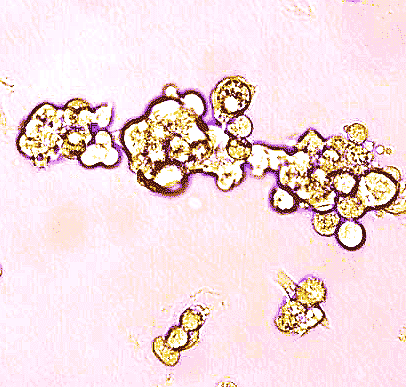| The
Era of Designer Cell Engineering
Andrea
Friedlander
Insulin use to treat diabetes
has long been established. Could there be a new treatment
for diabetics?
Blood sugar is converted
to energy by a hormone called insulin, which is produced
by a cell in the human pancreas called a ß-cell.
Type 1 diabetes is
said to occur where ß-cells are not present or not
functioning to perform this task. Current therapy for
type 1 diabetes involves giving the body “shots” of insulin,
usually by injection. These methods replace the insulin
that is absent in a diabetic but it does not mimic the
natural methods which the body naturally introduces in
a healthy individual. Fluctuations of blood glucose levels
from the artificial insulin can cause long term complications
such as damage to your eyes, kidneys, and peripheral nerves.
ß -cells produce insulin
on a minute-by-minute basis, consistent with the body's
needs. When glucose levels are high insulin acts to transport
glucose into the cell. This microscopic type of regulation
cannot be as finely controlled with two or three daily
injections of insulin. Rather than supplementing the body
with artificial insulin, there are new horizons in achieving
the body's natural way of modulating insulin for people
with type 1 diabetes.
Analogous to an organ transplant,
there are new therapies being developed which involves
the transplantation of healthy insulin-producing cells
to replace the Type 1 diabetics' ß-cells that do
not produce insulin. The transplanted ß-cells cells
would regulate glucose levels much as the body does in
people without diabetes, by responding to the body's constantly
changing requirements.
Recently, human trials have
commenced elsewhere with ß-cells isolated from the
pancreas of human donors. One of the shortcomings of this
technique is a non-scientific concern. There is a shortage
of donors, with 206 Australians donating organs in 2002
and 100,000 people in this country with type 1 diabetes.
The Diabetes Transplant Unit
(DTU), under the direction of Professor Bernie Tuch at
the Prince of Wales Hospital is concentrating on a number
of methods to generate healthy ß-cells that can
be transplanted into diabetes patients. Researchers at
the DTU were the first group in the world to successfully
normalize blood glucose levels of diabetic pigs transplanted
with immature pig ß-cells. Currently, transplantation
of these cells is being carried out into monkeys in pre-clinical
trials. Draft guidelines for transplanting such cells
into humans have recently been developed by the National
Health and Medical Research Council of Australia. Not
surprisingly Professor Tuch indicated that it was only
a matter of time before the guidelines were finalized
and ratified, and applications for human trials with pig
ß-cells could be submitted for consideration.
Further exciting possibilities
in the creation of healthy ß cells are from the
use of stem
cells that have yet to specialise and be committed
to a tissue or organ. This property has been the focus
of scientific research as it opens up the possibility
for the growth of desired tissue or organs, including
pancreatic ß-cells, which can be transplanted into
patients (Stocum 2002; Stanworth and Newland 2002).
 |
 |
Stem cells under the microscope
Image : East Carolina University
|
 |
Stem cells can be found in
3-5 day embryo's and in the bone marrow of adults. The
use of adult
stem cells (AS) has the advantage in that they could
be taken from the patient, cultured, and reintroduced,
AS cells are also less ethically problematic in the political
arena compared to the use of embryonic
stem cells, which are harvested from embryonic tissue,
such as excess embryos from in vitro fertilization efforts.
However, in the DTU lab, embryonic stem cells (ES) are
more readily converted into ß cells despite the
fact that researchers there have been experimenting for
a longer time on the AS cells.
In December 2002 federal
legislation was passed permitting scientists not only
to work with existing ES cell lines but also to create
new lines from surplus in vitro fertilization embryos.
Researchers in the DTU have been successful in converting
mouse ES cells into ß cells, and they are attempting
the same outcome with human ES cells. With the achievements
of the DTU thus far, and the support of Australian parliamentarians
in backing regulated, embryonic stem cell research, it
is clear that this team of scientists will impact and
facilitate the quest to create new ß cells, perhaps
progressing toward freeing diabetics from their daily
injections.
References
Bliss, M. 1988 The discovery
of insulin, Faber and Faber, London Boston
Online NHMRC;
http://www.nhmrc.gov.au/issues/xeno.htm
Stocum, D.L. 2001 Stem cells
in regenerative biology and medicine. Wound Repair
& Regeneration. 9(6), 429-42
Stanworth, S.J. and Newland A.C. Stem cells: progress
in research and edging towards the clinical setting. Clinical
Medicine. 1(5), 378-82
Glossary
Adult stem cells:
Undifferentiated cells found among differentiated cells
in a tissue or organ. These cells can renew themselves,
and can differentiate to yield major specialised cell
types of the tissue or organ. For example, adult tissues
such as the bone marrow and brain have discrete populations
of adult stem cells that can generate replacements for
cells that are lost through injury or disease. The origin
of adult stem cells in mature tissues is unknown. Adult
stem cells cannot be proliferated in the long term in
the laboratory without differentiating.
ß
(beta) cells:
Insulin producing cells of the pancreas.
Embryonic
stem cells:
Puripotent cells derived from the inner cell mass of a
3-5 day old embryo. Embryonic stem cells can generate
many cell types of the body derived from all three embryonic
cell types: endoderm, mesoderm and ectoderm. These cells
can be proliferated for a year or more in the laboratory
without differentiating.
Stem cells:
Unspecialised cells that renew themselves for long periods
through cell division. They can be induced to become cells
with special functions, such as the insulin-producing
cells of the pancreas.
|